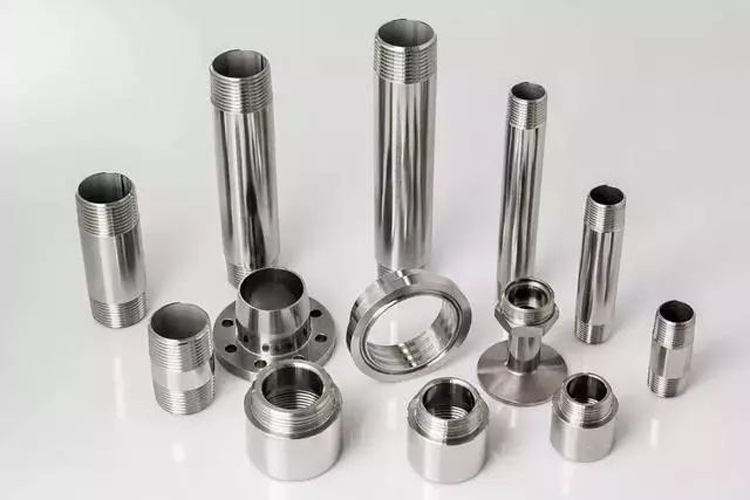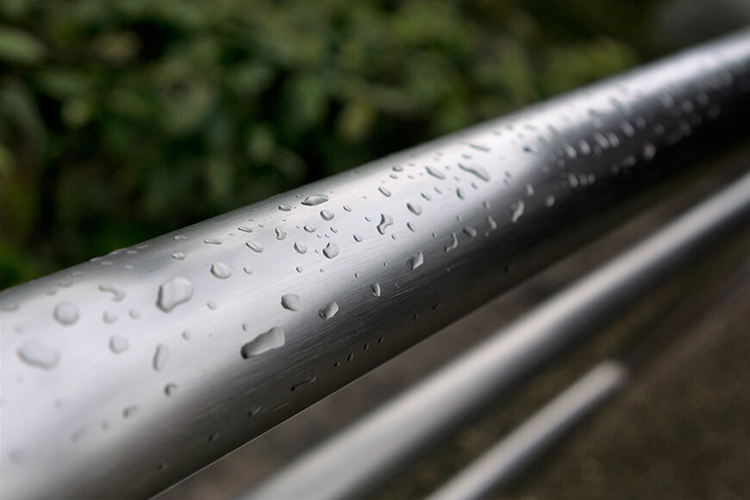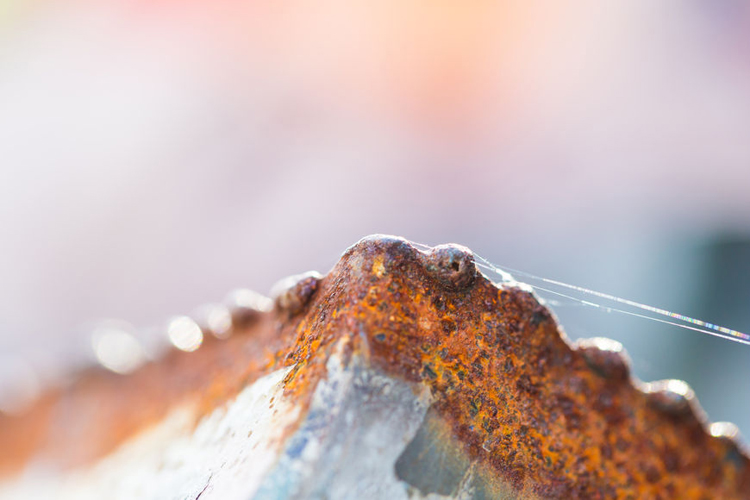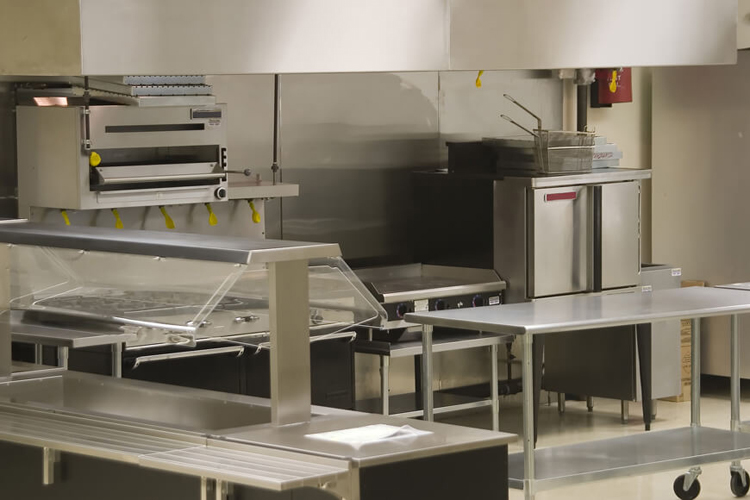What is the difference between 201 stainless steel and 304 stainless steel?
 What is the difference between 201 st...
What is the difference between 201 st...Stainless steel is the abbreviation of stainless acid-resistant steel. Steel grades that do not react to weak corrosive media such as air, steam, and water, or have rust properties, are called stainless steel, while those that do not react to chemical corrosive media (acid, alkali, salt and other chemical etching) are called stainless steel. Acid resistant steel.

1)The content of alloying elements.
Generally speaking, the content of chromium is 10.5%, and the steel is not easy to rust. The higher the content of chromium and nickel, the better the corrosion resistance. For example, the content of nickel in 304 material is 8-10%, and the content of chromium is 18-20%. Such stainless steel will not rust under normal circumstances.
2) The smelting process of the manufacturer will also affect the corrosion resistance of stainless steel.
A large stainless steel plant with good smelting technology, advanced equipment and advanced technology can ensure the control of alloying elements, the removal of impurities, and the control of the cooling temperature of the billet, so the product quality is stable and reliable, the internal quality is good, and it is not easy to rust. On the contrary, some small steel mills have backward equipment and backward technology. During the smelting process, impurities cannot be removed, and the products produced will inevitably rust.

3) The external environment, the climate is dry and ventilated, and the environment is not easy to rust.
The air humidity is high, continuous rainy weather, or environmental areas with high pH in the air are prone to rust. 304 stainless steel, if the surrounding environment is too bad, it will rust.
1) Chemical method
Use pickling paste or spray to assist the re-passivation of the rusted part to form a chromium oxide film to restore the corrosion resistance. After pickling, in order to remove all contaminants and acid residues, it is very important to rinse properly with clean water. After all processing, re-polish with polishing equipment, and seal with polishing wax. For local slight rust spots, you can also use a 1:1 mixture of gasoline and engine oil to wipe off the rust spots with a clean rag.
2) Mechanical method
Sandblast cleaning, blast cleaning with glass or ceramic particles, annihilation, brushing and polishing. It is possible to mechanically wipe away contamination from previously removed material, polishing material, or submerged material. All kinds of contamination, especially foreign iron particles, can be a source of corrosion, especially in humid environments. Therefore, mechanically cleaned surfaces should preferably be properly cleaned in dry conditions. The use of mechanical methods can only clean the surface, and cannot change the corrosion resistance of the material itself. Therefore, it is recommended to re-polish with polishing equipment after mechanical cleaning and seal with polishing wax.

1) 304 stainless steel. It is one of the most widely used and widely used austenitic stainless steels. It is suitable for the manufacture of deep-drawn parts and acid pipelines, containers, structural parts, various instrument bodies, etc. It can also be used to manufacture non-magnetic, low-temperature equipment and part.
2) 304L stainless steel. In order to solve the problem of the development of ultra-low carbon austenitic stainless steel due to the precipitation of Cr23C6 causing serious intergranular corrosion tendency of 304 stainless steel under some conditions, its sensitized state intergranular corrosion resistance is significantly better than that of 304 stainless steel. Except for the slightly lower strength, other properties are the same as 321 stainless steel. It is mainly used for corrosion-resistant equipment and components that cannot be subjected to solution treatment after welding, and can be used to manufacture various instrument bodies.
3) 304H stainless steel. The internal branch of 304 stainless steel has a carbon mass fraction of 0.04%-0.10%, and its high temperature performance is better than that of 304 stainless steel.
4)316 stainless steel. On the basis of 10Cr18Ni12 steel, molybdenum is added to make the steel have good resistance to reducing medium and pitting corrosion. In seawater and various other media, the corrosion resistance is better than 304 stainless steel, mainly used for pitting corrosion resistant materials.
5) 316L stainless steel. Ultra-low carbon steel has good resistance to sensitized intergranular corrosion and is suitable for the manufacture of welded parts and equipment with thick section dimensions, such as corrosion-resistant materials in petrochemical equipment.
6) 316H stainless steel. The internal branch of 316 stainless steel has a carbon mass fraction of 0.04%-0.10%, and its high temperature performance is better than that of 316 stainless steel.

7) 317 stainless steel. The pitting corrosion resistance and creep resistance are better than 316L stainless steel, which is used in the manufacture of petrochemical and organic acid-resistant equipment.
8) 321 stainless steel. Titanium-stabilized austenitic stainless steel, adding titanium to improve intergranular corrosion resistance, and has good high-temperature mechanical properties, can be replaced by ultra-low carbon austenitic stainless steel. Except for special occasions such as high temperature or hydrogen corrosion resistance, it is generally not recommended for use.
9)347 stainless steel. Niobium-stabilized austenitic stainless steel, adding niobium to improve the intergranular corrosion resistance, the corrosion resistance in acid, alkali, salt and other corrosive media is the same as 321 stainless steel, and the welding performance is good, it can be used as a corrosion-resistant material and a corrosion-resistant material. Hot steel is mainly used in thermal power and petrochemical fields, such as making containers, pipes, heat exchangers, shafts, furnace tubes in industrial furnaces, and furnace tube thermometers.
10) 904L stainless steel. Super complete austenitic stainless steel is a super austenitic stainless steel invented by OUTOKUMPU in Finland. , It has good corrosion resistance in non-oxidizing acids such as sulfuric acid, acetic acid, formic acid and phosphoric acid, and also has good resistance to crevice corrosion and stress corrosion resistance. It is suitable for various concentrations of sulfuric acid below 70 °C, and has good corrosion resistance in acetic acid and mixed acid of formic acid and acetic acid at any concentration and temperature under normal pressure. The original standard ASMESB-625 classified it as nickel-based alloys, and the new standard classified it as stainless steel. China only has similar grades of 015Cr19Ni26Mo5Cu2 steel. A few European instrument manufacturers use 904L stainless steel as the key material. For example, the measuring tube of E+H mass flowmeter is made of 904L stainless steel, and the case of Rolex watches is also made of 904L stainless steel.
11)440C stainless steel. Martensitic stainless steel has the highest hardness among hardenable stainless steels and stainless steels, with a hardness of HRC57. Mainly used to make nozzles, bearings, valve cores, valve seats, sleeves, valve stems, etc.
12) 17-4PH stainless steel. Martensitic precipitation hardening stainless steel with a hardness of HRC44 has high strength, hardness and corrosion resistance and cannot be used at temperatures above 300°C. It has good corrosion resistance to the atmosphere and diluted acid or salt. Its corrosion resistance is the same as that of 304 stainless steel and 430 stainless steel. It is used to manufacture offshore platforms, turbine blades, valve cores, valve seat, casing, valve stem, etc.

| series | American Standard(ASTM) | National standard(GB) | Japanese label (SUS) | performance | use |
| 200 | 201 | ICr17Mn6NISN | SUS201 | It has the characteristics of acid resistance, alkali resistance, high density, no bubbles, no pinholes, etc. It is the production of various watchcases, strap bottom covers and other high-quality materials. | Mainly used as a decorative tube, industrial tube, some shallow tensile products. |
| 202 | ICrI8Mn8NI5N | SUS202 | Part of nickel is replaced with Mn and N, so as to obtain good mechanical properties and corrosion resistance. It is a new type of nickel-saving stainless steel. Its room temperature strength is higher than that of 304, and it has better oxidation resistance and corrosion resistance below 800 degrees. Medium temperature strength. | ||
| 2205 | 00Cr22NI5Mo3N | SUS2205 | Its Cr, Mo and N elements are relatively narrow, and it is easy to achieve the balance of the phases (that is, the two phases account for about half), which improves the strength, corrosion resistance and welding performance of the steel. It is mostly used for high performance requirements and welding needs. materials, such as oil and gas pipelines, etc. | For refining, fertilizers, paper, oil, chemical and other heat exchanger and cold ghare and devices. | |
| 300 | 304 | 1Cr18N19(06Cr18NiI0) | SUS304 | As a versatile steel, it has good corrosion resistance, heat resistance, low temperature strength and mechanical properties. Stamping, bending and other hot workability is good, no heat treatment hardening phenomenon (non-magnetic, operating temperature -196 ℃——800 ℃) | Food industry, household items |
| 304J1 | SUS304JI | Cu should be added, which has good formability, especially wire drawing and aging crack resistance, and can form products with complex shapes. Its corrosion resistance is the same as 304 steel. | Insulation bottle, kitchen washing tank, pot, pot, insulation lunch box, door handle, textile machining machine. | ||
| 304L | 00CrI9NiI0 | SUS304L | As a low-C 304 steel, in the general state, as a low-C 304 steel, in the general state, after stress relief, its resistance to grain boundary corrosion is excellent. In the case of no heat treatment, it can also maintain good corrosion resistance, generally used below 400 (non-magnetic, operating temperature -196℃——800℃) | Applications of chemical, coal carbon petroleum industry's field open-air machinery, building materials, heat-resistant parts and heat treatment with high corrosion-resistant requirements. | |
| 321 | 1Cr18Ni9Ti | SUS321 | Add a lower element to prevent grain boundary corrosion at 304 steel. Suitable for use at 430℃——900℃. | Agriculture, ship parts, atomic energy industry, aircraft, takeover, boiler steam parts (windshield wiper, muffler, mold). | |
| 316 | 0Cr17Ni12Mo2 | SUS316 | Painted plus Mo, so its corrosion resistance, the gas resistance and high temperature strength are particularly good, can be used under harsh conditions. Processing hardenability (no magnet) | Equipment, chemical, dye, paper, oxalic acid, fertilizer, etc. in seawater, fertilizer, etc. | |
| 316L | 00Cr17Ni14Mo2 | SUS316L | As the low C series of 316 steel, it has the same characteristics as 316 steel, its anti-product corrosion is excellent. | 316 Steel uses have special products with special requirements for anti-grain boundary. | |
| 309S | 0Cr23Ni13Mo2 | SUS309s | 23Cr-13Ni high alloy steel stainless steel, excellent corrosion resistance and strength, suitable for working temperature in components of 1000℃ | Exhaust machine, heat treatment furnace and heat exchange, etc. | |
| 310S | 0Cr25Ni20Si2 | SUS310S | Very good oxidation resistance, corrosion resistance, high temperature resistance, because of higher percent chrome and nickel, 310S has a high percentage of chromium and nickel, 310S has a much more creep strength, can continue to work at high temperatures . | Boiler, exhaust machine, heat treatment furnace and heat exchange machine, etc. |
 What is the difference between 201 st...
What is the difference between 201 st... Why is 316 stainless steel better tha...
Why is 316 stainless steel better tha... 400 series stainless steel science
40...
400 series stainless steel science
40... How to distinguish the processing tec...
How to distinguish the processing tec... Non-standard design materials of bras...
Non-standard design materials of bras... What type of titanium alloy does Tc4 ...
What type of titanium alloy does Tc4 ...